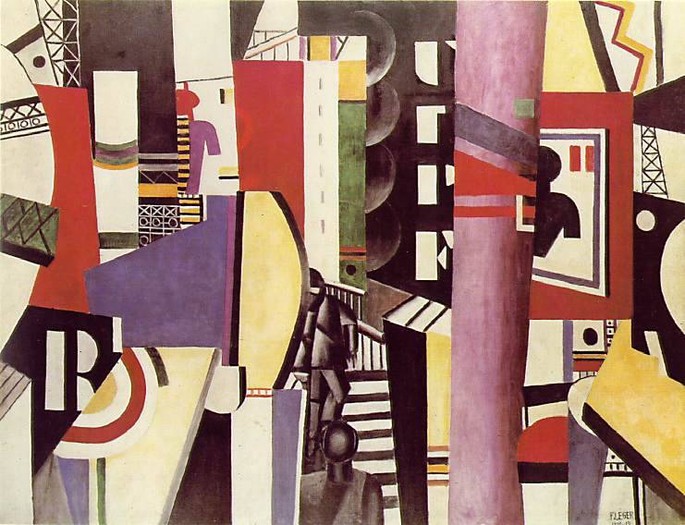Léger was born February 4, 1881 in Argentan, Orne, Lower Normandy, where his father raised cattle. He studied as an architect from 1897 to 1899, before moving in 1900 to Paris. He attended the Beaux-Arts as a non-enrolled student, spending what he described as "three empty and useless years" studying with Gérôme and others, while also studying at the Académie Julian.
He began to work as a painter at the age of 25. His work showed the influence of impressionism, for instance in Le Jardin de ma mère (My Mother's Garden) of 1905, one of the few paintings from this period that he did not destroy later. After he saw the Cézanne retrospective at the Salon d'Automne in 1907, a new emphasis on drawing and geometry appeared in Léger's work.
In 1909 he moved to Montparnasse and met the avant-garde of Archipenko, Lipchitz, Chagall, Joseph Csaky and Robert Delaunay. His major painting of this period is Nudes in the Forest (1909–10), in which Léger displays a personal form of Cubism that his critics termed "Tubism" for its cylindrical forms. In 1910 he exhibited at the Salon d'Automne together with Jean Metzinger and Henri Le Fauconnier. They were responsible for revealing Cubism to the general public for the first time as an organized group, in 1911. Later, with other painters, he formed the "Puteaux group" also known as Section d'or.
Léger's paintings, from then until 1914, became increasingly abstract. Their tubular, conical, and cubed forms are laconically rendered in rough patches of primary colors plus green, black and white, as seen in the series of paintings with the title Contrasting Forms. Léger made no use of the collage technique like Braque and Picasso.
World War I had a significant effect on his work. He made many sketches of artillery pieces, airplanes, and fellow soldiers while in the trenches, and painted Soldier with a Pipe (1916) while on furlough. In September 1916 he almost died after a mustard gas attack at Verdun. During a period of convalescence he painted The Card Players (1917), whose robot-like, monstrous figures reflect his experience of war.
Starting in 1918, he also produced the first paintings in the Disk series, in which disks suggestive of traffic lights figure mainly. In 1920 he met Le Corbusier, who would remain a lifelong friend.
In the 1920s , the Mother and child, The female nude, Figures in an ordered landscape—are typical of the postwar "return to order" in the arts, and link him to the tradition of French figurative painting represented by Poussin and Corot. In his Paysages animés (animated landscapes) of 1921, he recalls the works of Henri Rousseau, an artist Léger greatly admired and whom he had met in 1909. Léger's Nude on a Red Background (1927) depicts a monumental, expressionless woman, machinelike in form and color. The Siphon of 1924, a still life based on an advertisement, represents the high-water mark of the Purist aesthetic in Léger's work.
As an enthusiast of the modern, Léger was greatly attracted to cinema, and for a time he considered giving up painting for filmmaking. In 1924, Léger produced and directed the iconic and Futurism-influenced film, Ballet Mécanique (Mechanical Ballet). Neither abstract nor narrative, it is a series of images of a woman's lips and teeth.
From 1927 on, the character of Léger's work gradually changed, in the Two Sisters of 1935, and in several versions of Adam and Eve. With characteristic humor, he portrayed Adam in a striped bathing suit, or sporting a tattoo, The figural style that emerged in the 1930s is fully displayed in those pictures.
In 1938, Léger was commissioned to decorate Nelson Rockefeller's apartment. During World War II Léger lived in the United States. His enthusiasm for contrasts between mashines and nature, resulted in works as The Tree in the Ladder of 1943–44, and Romantic Landscape of 1946. He also painted Three Musicians (Museum of Modern Art, New York) in 1944.
Returned to France in 1945, his work became less abstract, and he produced many monumental figure compositions depicting scenes of popular life featuring acrobats, builders, divers, and country outings. He projected book illustrations, murals, stained-glass windows, mosaics, polychrome ceramic sculptures, and set and costume designs.
In his final years he lectured in Bern, designed mosaics and stained-glass windows for the Central University of Venezuela in Caracas and painted Country Outing, The Camper, and the series The Big Parade. In 1954 he began a project for a mosaic for the São Paulo Opera, which he couldn't finish. Fernand Léger died at his home August 17, 1955 and is buried in Gif-sur-Yvette, Essonne.
In 1960, the Musée Fernand Léger was opened in Biot, Alpes-Maritimes, France.
[Next week an article about the museum].





























